Aloe Veras are fast-growing succulents. But, if compared to other plants, they grow slowly. Aloes can reach a height and width of 24-39 inches. However, it is frustrating to see them not grow despite providing proper care. But are you giving them the right care and maintenance? Let’s find out.
Generally, Aloe vera plant stops growing during the summer months when the temperature exceeds 80-90°F. Lack of direct sun or too much shade can also inhibit the growth of the aloe vera plant. Provide appropriate conditions to your aloe vera plant to boost its growth.
Every gardener will face this issue with their aloe vera at some point. This article will give you the reasons behind Aloe Vera not growing and how to deal with it. We will also share some tips for growth in the plant.
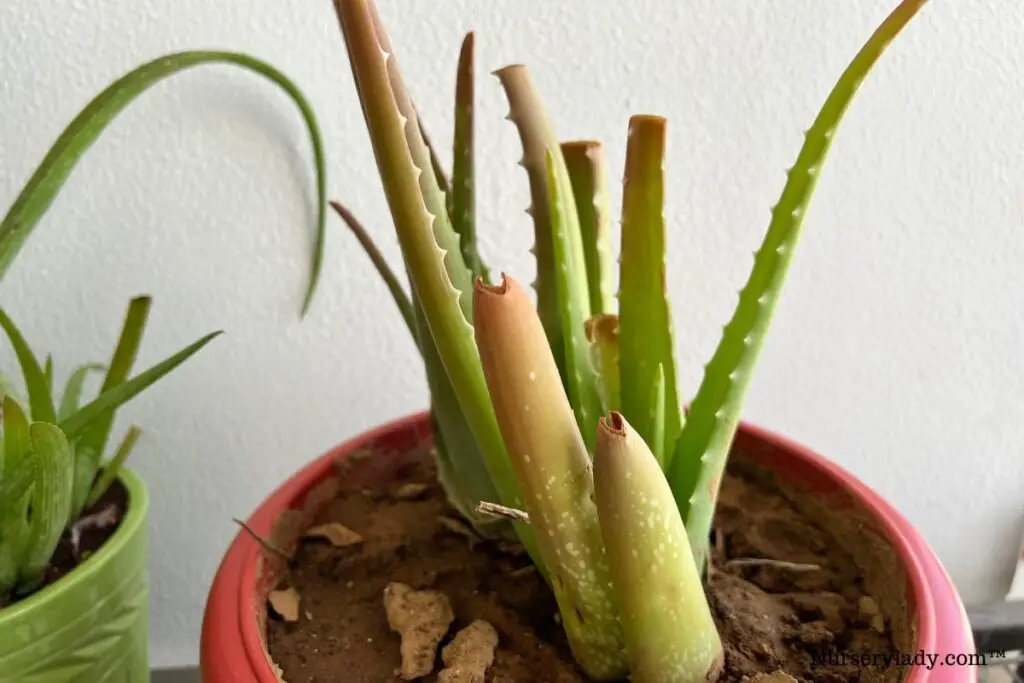
Why is my Aloe Vera not growing?
There are several reasons behind Aloe Vera not growing or growing slowly.
Some of them are the plant’s natural response to the surrounding environment, and some are problems that occur because of your mistakes.
But, don’t worry as we have covered everything in this guide.
The reasons behind Aloe Vera not growing are:
- Summer dormancy
- Winter season
- Temperatures
- Lack of sunlight
- High moisture levels
- Very large planters
- Root-bound
- Overcrowding
- Infestations
You cannot do anything about the natural reasons.
You have to wait until the surrounding environment becomes normal.
But you must deal with the problems to encourage further growth in the plant.
So, let’s learn how they are responsible for stopping the Aloes from growing.
Summer dormancy
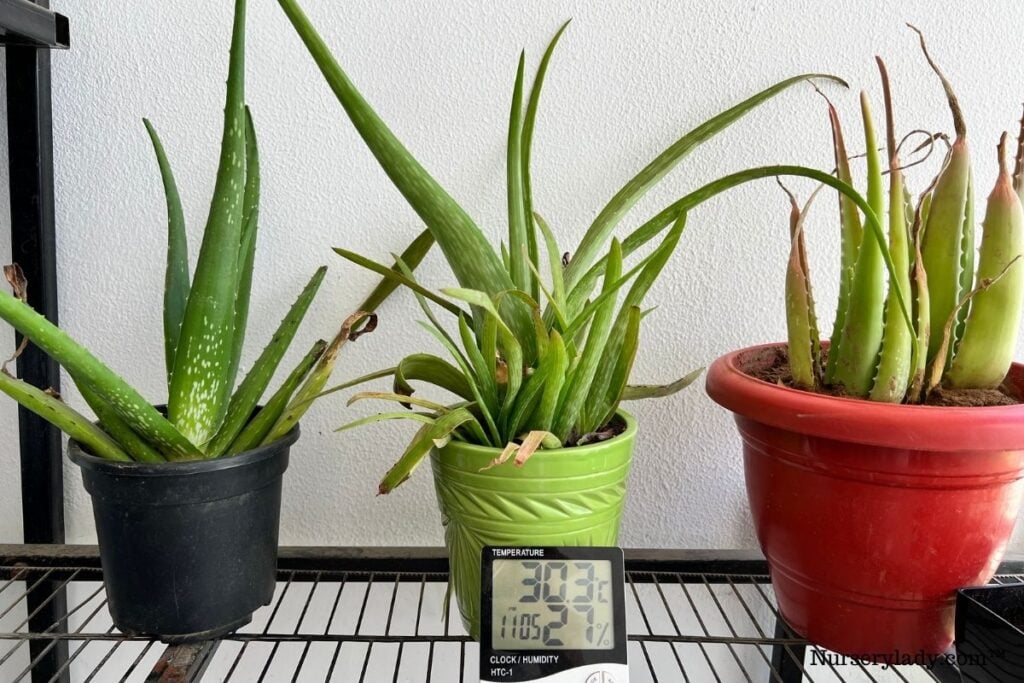
Aloe Veras are native to the dry areas of the Arabian Peninsula.
They grow best in desert areas where the temperature is warm and the growing medium is dry.
Though the growing period of Aloe Vera is spring and summer, they will stop growing if the temperature crosses 80-90°F.
They will start to conserve the water to utilize it to survive during the dry weather.
It is difficult for other plants to handle such dryness.
But, Aloes can manage due to their water storage capacity and summer dormancy.
Aloes can survive a dry climate with high temperatures by the water stored in the leaves, opening the stomata at night to reduce transpiration and slowing its growth to decrease their water needs during high temperatures.
This cycle of growth and dormancy is very natural in the plant, and it doesn’t indicate any stress.
This resting period also allows the plant to grow vigorously once the dormancy ends.
The plant will again start growing once the temperature becomes normal during the cool weather in the fall, winter, and spring.
However, they might also grow slowly in winters due to shorter days.
It is common for the Aloes to suffer from overwatering during the summers.
They don’t need daily watering like the other plants during summer.
When dormant, the Aloe Vera reduces its water requirements.
They don’t consume the water because they are resting and not growing.
If you notice that the leaves have turned yellow or brown, soft and mushy, you should stop watering for some days and let them dry out.
So, you must be careful while watering Aloes during the summers.
Also read: Aloe Vera Temperature Tolerance: Ideal Temperature+Keeping Them Safe
Winter season
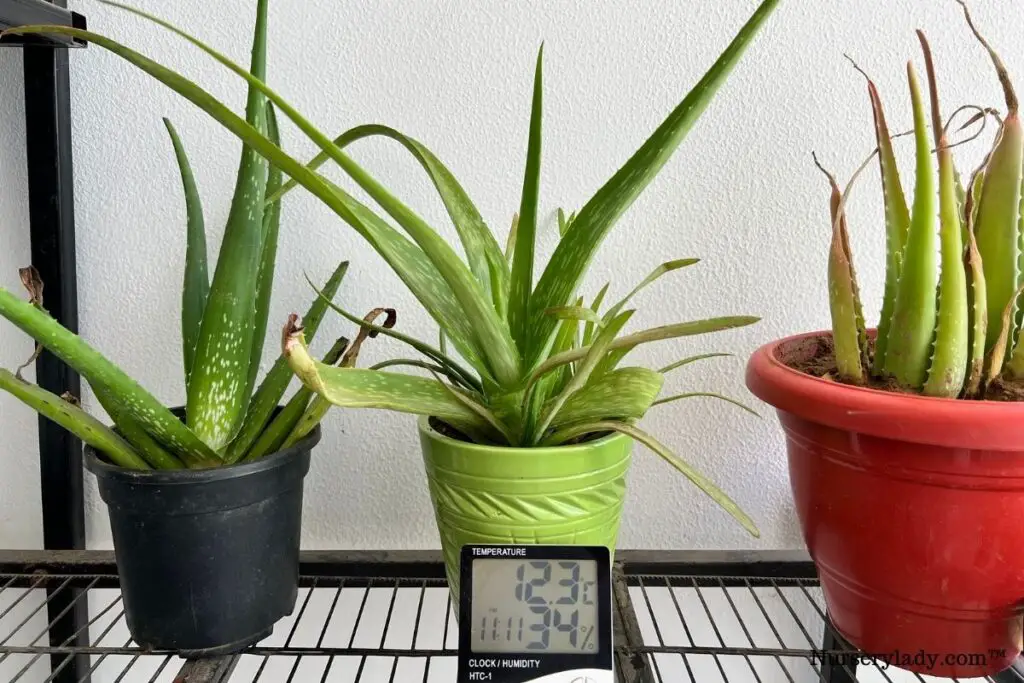
As I mentioned earlier, the Aloes will also slow down their growth during the winters.
The Aloe Vera plants stop growing during the winters because:
- The days are shorter, and thus, the sunlight stays for a short period.
- The intensity of the sun lowers during winters.
- Most of the days are overcast and cloudy.
- The temperatures are lower than the Aloes need.
Since the weather is dry, the evaporation rate is slower than normal
Aloe Vera requires enough sunlight for 5-6 hours to grow quickly.
But with a few hours of sunlight with low intensity during the winters, they won’t be able to grow at their optimal rate.
Due to such less sunlight, the plant will naturally slow down its growth.
But, you don’t need to worry about it because once the winter gets over and the sunlight hours and intensity will increase.
The plant will start growing again.
You should place them in the sunniest of your house or garden.
It keeps the Aloes warm during winters and gives them enough sunlight to keep them growing.
Though you can let them have the direct sunlight outdoors, it might not work the same way indoors.
To fulfill the light requirement, use artificial lights to increase the lighting hours.
Also read: Is Aloe Vera Indoor Or Outdoor Plant? (+Care Difference)
Cold Temperatures
Aloe Veras requires a temperature ranging between 55-75°F.
They cannot tolerate cold temperatures because they tend to grow under warm temperatures.
Low temperatures are their enemy, and Aloes will slow down if exposed to lower temperatures.
Some cold-hardy Aloes can tolerate temperatures around 20-25°F, but if you expose them to temperatures lower than this, they will struggle to survive and grow slowly.
In such conditions, you won’t be able to see much growth in them.
Generally, Aloes belong to the USDA hardiness zones 9 to 12.
But, if your region receives too low temperatures with frost, you should grow Aloes in containers to bring them inside during the second half of the fall.
It will stop them from being slow.
At temperatures within 55 to 75°F, the Aloes don’t have to face any cold or high temperatures.
Also, make sure that they are not close to:
- Windows or doors that you frequently open and close or remain open most of the time
- Air conditioners or fans
- Heaters, radiators, fireplaces, or ovens
These areas can give the Aloes extremely low or high temperatures, humidity, and temperature fluctuations.
High humidity also leads to high moisture levels.
The result of high moisture content also seizes the growth. We will explain it later.
Also read: Can Aloe Vera Plants Survive Cold Weather? (+Deal With Cold Damage)
Lack of light

Aloe Vera thrives best in areas with dry climates and full or partial sunlight.
They prefer the morning sun for 5-6 hours with some shade from the mid-day and afternoon sun.
If Aloes receive indirect light or complete shade, they will slow down their growth like the winter season.
The more sunlight they get, the faster and bigger the Aloes will grow.
Slow growth due to low light levels occurs when they grow indoors.
It is because they don’t get the full sun like outdoors. There is a lot of shade inside the house.
If your plant is growing slowly and not getting enough sunlight, you should let it have the required sunlight.
Place them near a south or west-facing window.
Sometimes, this direction might give too intense sunlight that can burn the leaves.
So, you can try the north or east-facing window.
You can also shift them outdoors, but acclimatization is necessary.
Expose the Aloes to the sunlight and increase the timing gradually.
Once they adjust themselves to the full sun, they will grow faster.
Don’t plant the Aloe Veras under any big tree or shady area.
Find the sunniest spot in your garden and plant it there.
If necessary, you can fix transparent shading nets during the summers if the sunlight is too intense.
But never plant them under the full shade.
Also read: What Kind Of Light For Aloe Vera Plants? (Full sun, Shade, Or Partial Light?)
Looking for gardening supplies? We have tested 100's of products before recommending them to you guys. Check out our best pick below:
| Image | Gardening Supplies | Best Price? |
|---|---|---|
 Top
Top Top
Top | Raised Garden Bed Kit | Check On Amazon |
 | XLUX Soil Moisture Meter, Plant Water Monitor, Soil Hygrometer Sensor for Gardening, Farming, Indoor and Outdoor Plants, No Batteries Required | No Results |
 Top
Top Top
Top | 82 Pcs Garden Tools Set and Extra Succulent Tools Set | Check On Amazon |
 | Joeys Garden Expandable Garden Hose with 8 Function Hose Nozzle, Lightweight Anti-Kink Flexible Garden Hoses, Extra Strength Fabric with Double Latex Core, (50 FT, Black) | No Results |
 Top
Top Top
Top | Dual Chamber Compost Tumbler | Check On Amazon |
 Top
Top Top
Top | Sunnyglade Plant Stakes | Check On Amazon |
 Top
Top Top
Top | Organic Cold Pressed Neem Seed Oil | Check On Amazon |
 Top
Top Top
Top | Mighty Mint Gallon :-Insect and Pest Control Peppermint Oil | Check On Amazon |
 Top
Top Top
Top | Scotts DiseaseEx Lawn Fungicide | Check On Amazon |
 Top
Top Top
Top | Jacks Classic 20-20-20 All Purpose Fertilizer | Check On Amazon |
 Top
Top Top
Top | 30,000 Seeds Pollinator Attracting Wildflower Mixture | Check On Amazon |
 Top
Top Top
Top | Survival Vegetable Seeds Garden Kit-Over 16,000 Seeds | Check On Amazon |
Excessive moisture around the roots
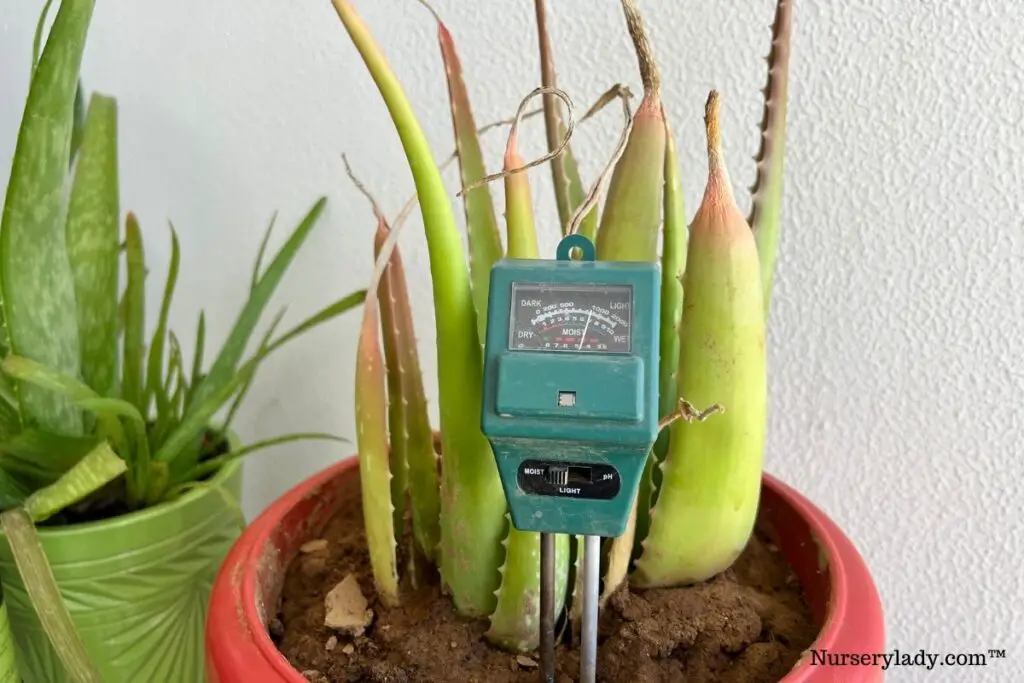
Aloes are resilient to dry conditions because they are naturally adapted to grow in dry weather conditions accompanied by infrequent rainfall and well-drained soil.
The soil in their native land is very sandy, and thus, they don’t retain moisture for a long time.
Besides, they also store water in their leaves.
Due to their adaptation to dry conditions, Aloe Veras are very sensitive to high moisture.
3 situations are responsible for high moisture levels:
- You water too often without letting the soil dry
- The soil is not draining enough water
- The container doesn’t have drainage holes
Excessive moisture levels will result in yellow, soft, and mushy leaves with dark brown and mushy roots.
The plant will stop growing due to high moisture levels even if they don’t show such signs.
Let the top 2-3 inches of the soil dry out before watering.
If you want to follow a routine, provide water once in 2-3 weeks.
This may differ depending on situations like time of the year, climate or plant size, or maturity.
So, instead of following a routine, check the moisture level to perform correct watering.
Always check the drainage.
Use lightweight and well-drained soil for Aloes. You can use cactus potting mix or make your mix by adding materials like coarse sand, pumice, or perlite.
If you are using a container, check the drainage system.
Make one by drilling if there isn’t any.
You must also check the humidity level.
Since Aloes love dry conditions, they won’t enjoy high humidity as it increases the moisture content greatly.
It must always remain within 30% to 40% or lower.
Humidity problem is more indoors due to lack of light and airflow.
Make sure that your plant receives enough light and airflow.
It can reduce the humidity to a great level.
Avoid areas like bathrooms, kitchens, aquariums, or fireplaces.
Also read: How To Water Aloe Vera Plant? (How often, Summer, Winter)
Large planter
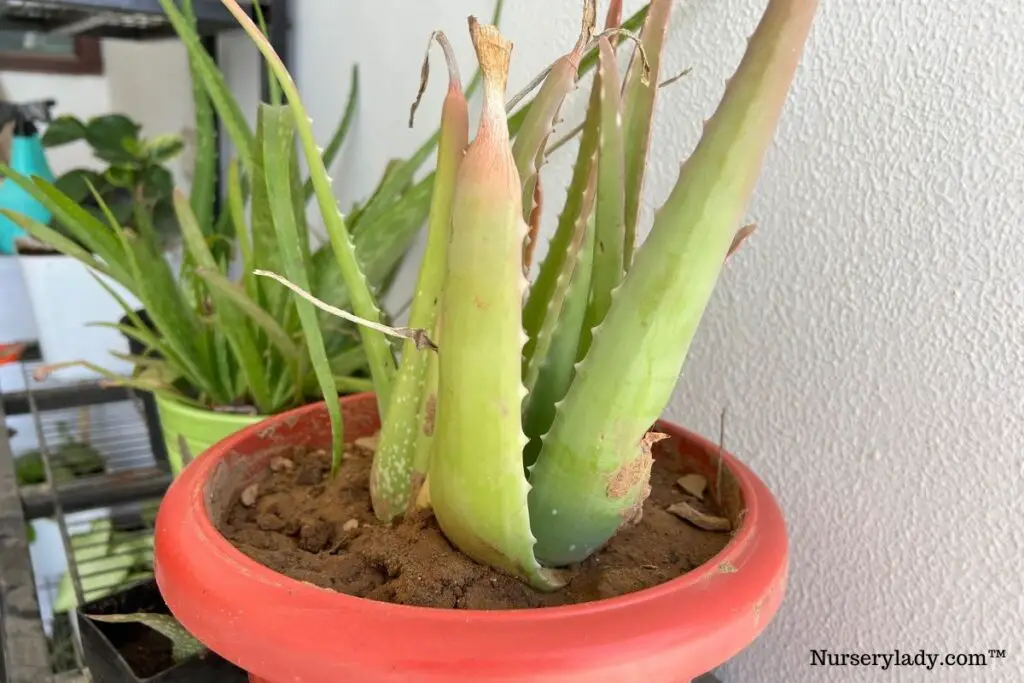
There has been evidence that the Aloe Vera plant won’t grow well if you plant them in a pot bigger than the plant and its root ball.
A large container needs soil in great quantity.
When there is too much soil, the plant concentrates more on the growth of the roots than the plant.
Due to this, there is no growth seen in the plant.
Similarly, the soil with such a high quantity will take time to dry out when watered.
It will have the capacity to retain moisture for a long time, thus resulting in high moisture levels.
That is why the plant will seize its growth.
You must always select a container only 1-2 inches bigger than the root ball and 1/3rd bigger than the plant.
It can prevent fast root-bound and overcrowding.
While repotting Aloes, choose a container 1-2 inches bigger than the present one.
Rootbound plant
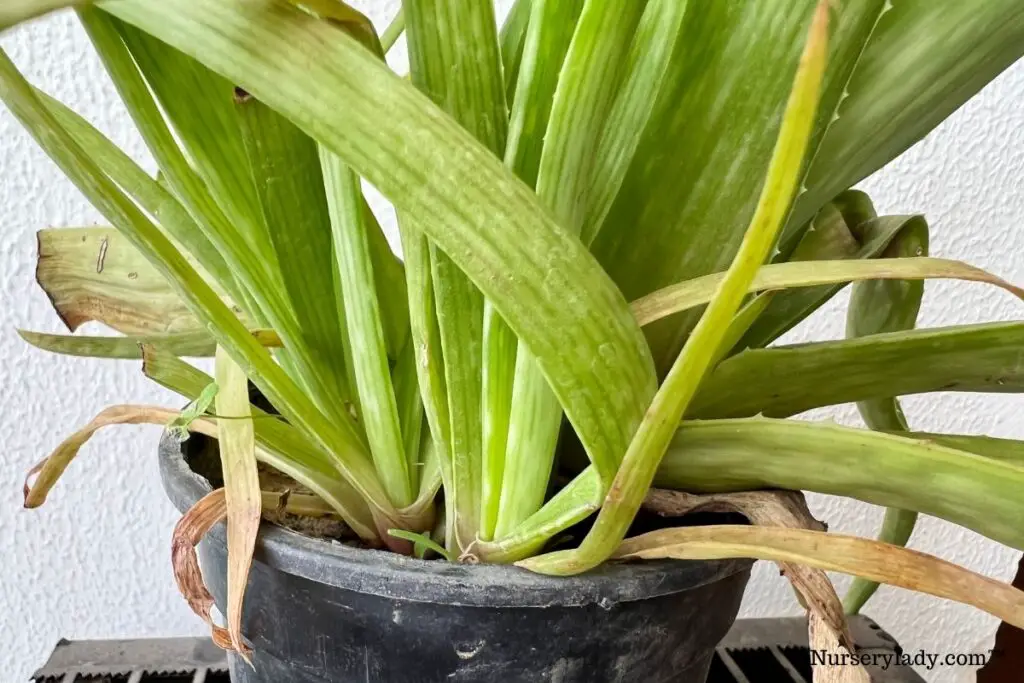
Slightly root bound is okay for the Aloe Vera plants.
But if they stay like that for a very long time, they experience water, nutrients, and space deficiencies.
Due to extreme root-bound conditions, the roots will grow in a circular motion, grow out of the drainage holes and stay compact.
Due to a lack of water, nutrients, and space, the plant’s smooth growth and development will be interrupted.
Because of this intervention, the plant will slow down and ultimately stop growing if the condition extends longer.
You must repot the Aloes at least once in 1-2 years.
Also read: Does Aloe Vera Plant Like To Be Root Bound? (Possible Problems+Repot)
Overcrowding
Like root-bound, the plant will undergo problems if they are overcrowded with pups.
Both rootbound and overcrowding are linked.
The plants struggle for water, nutrition, and space in both conditions.
The pups take up all the energy from the main plant and make it weak.
When the whole family fights and struggles to remain alive for a long period, the plant ultimately stops growing.
As I said earlier, you should repot them every 1-2 years.
This gives the plant the chance to separate the pups and more space to grow and spread.
Also read: How To Repot An Aloe Vera Plant? (Step-by-Step Guide)
Infestations
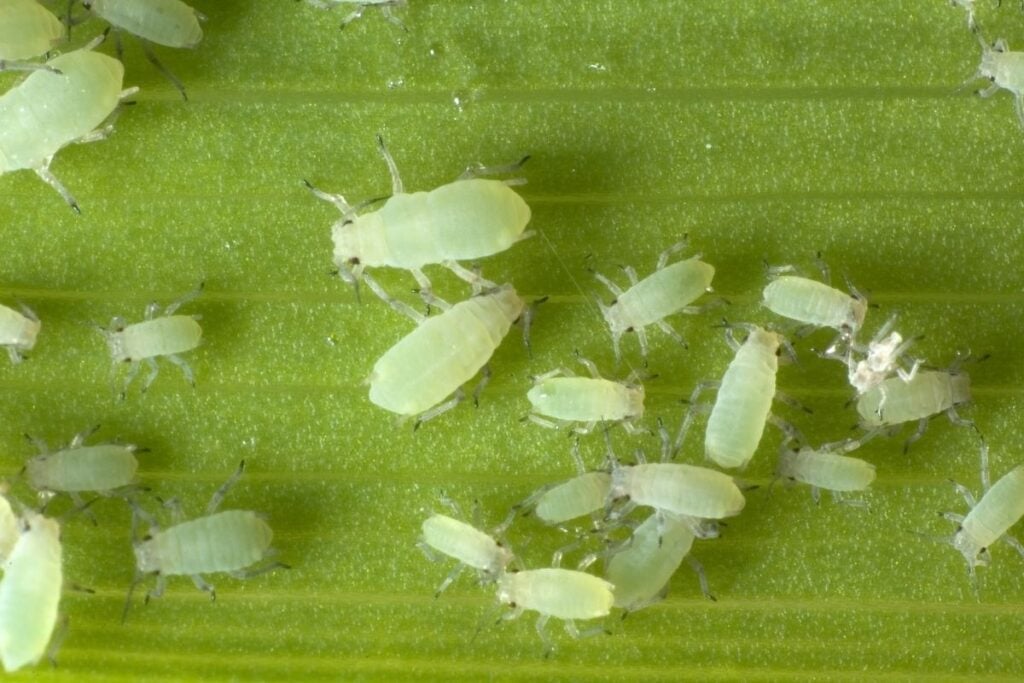
If bug infestation occurs, it will lead to stunted growth.
Bugs like mealybugs, aphids, spider mites, aloe mites, scales, etc., can suck the plant sap and make it lifeless.
As a result, the plant will not grow at its usual pace.
It will grow very slowly or stop growing due to the attack.
You can get rid of them with neem oil, horticultural oils, insecticidal soaps, soapy water, and rubbing alcohol.
You can also release ladybugs.
They will feed on aphids and soft-bodied scales and make your plant pest-free.
For clearing the bugs that enjoy damp conditions, allow the soil to dry out.
Avoid watering for some days.
To remove the bugs that like dry conditions, shower the plant.
How can I make my Aloe Vera grow faster?
Though some of the reasons are natural and some are a problem, you can still encourage Aloe Veras to grow if you follow the tips I will share below.
Let’s have a look at the tips:
Light
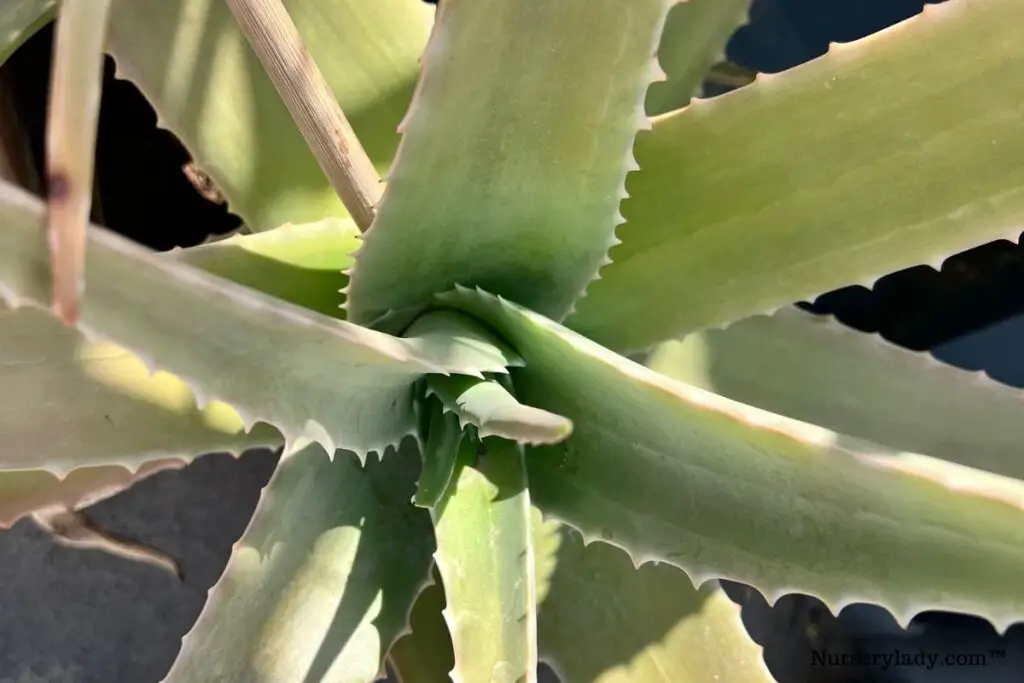
Provide Aloe Veras daily with at least 5 to 6 hours of sunlight.
They prefer the morning sun with some shade during the mid-day or afternoon.
Never deprive them of light.
If your plant is getting insufficient light indoors, shift them outdoors, place them near a sunny window or use artificial lights.
Don’t forget to acclimatize.
Also read: What Kind Of Light For Aloe Vera Plants? (Full sun, Shade, Or Partial Light?)
Water
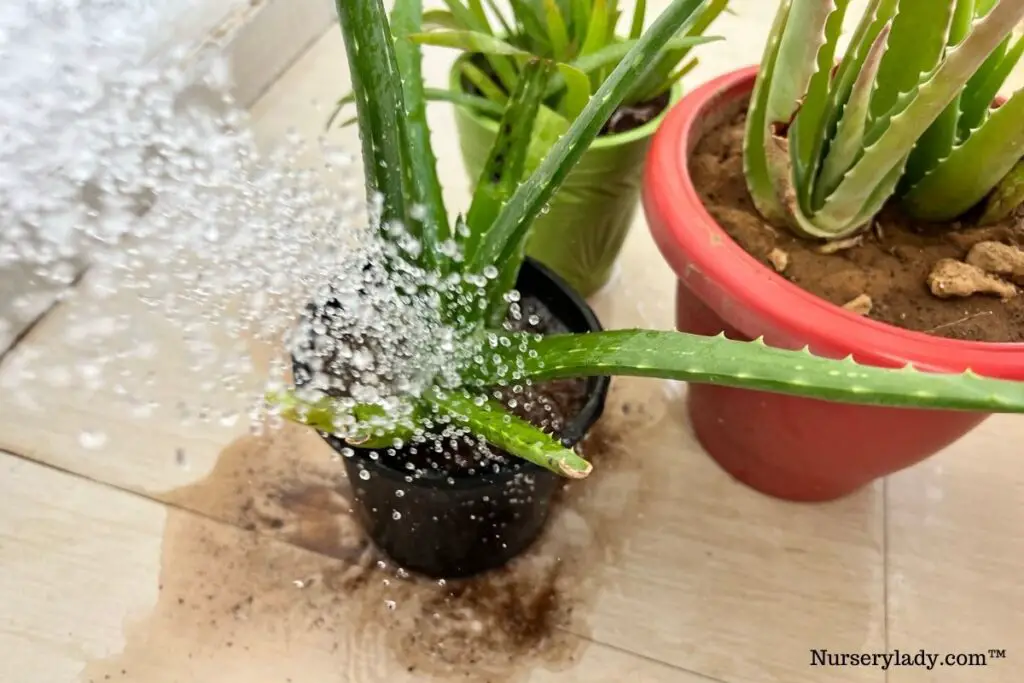
Water them once in 2-3 weeks during their growing season.
It might differ depending on some factors, like the season or plant size and maturity.
So, always check the moisture level of the soil before watering.
It should be at least 2-3 inches dry from the top.
Don’t bother with watering during their summer dormancy.
They will be dormant when the temperature exceeds 80-90°F.
However, you can stop the dormancy if you bring them indoors.
But I would suggest letting the Aloes have the dormancy.
It allows the plant to conserve energy and water during dry weather.
Dormancy also permits the plant to grow busily once the normal temperature is back.
Also read: How To Water Aloe Vera Plant? (How often, Summer, Winter)
Soil
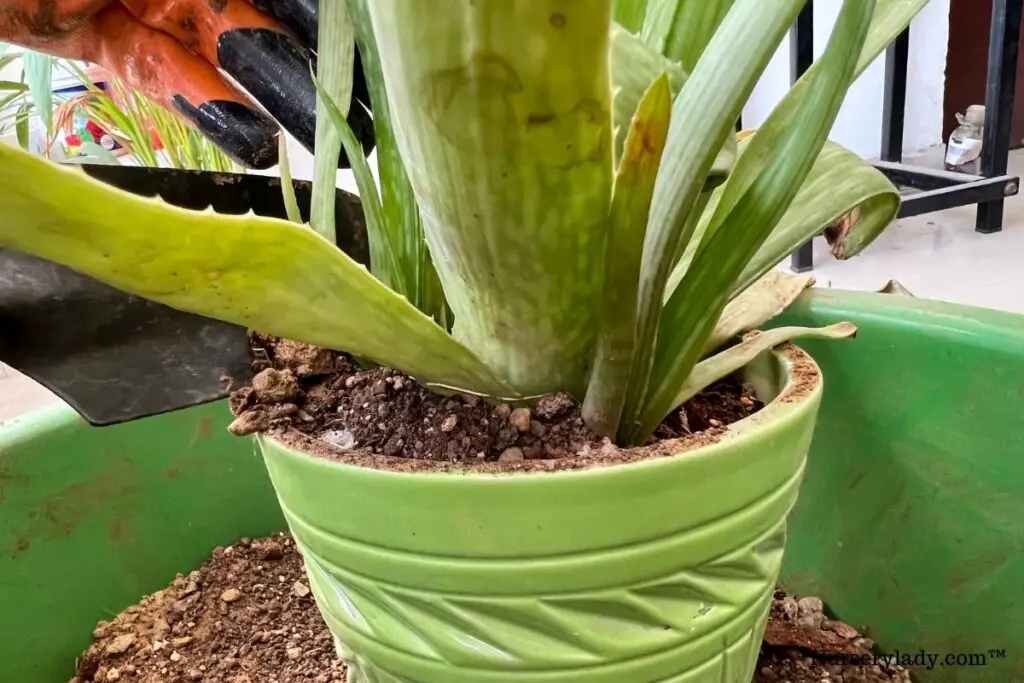
Always use well-drained soil for Aloes.
It can save your plant from high moisture levels and keep them dry, just like they used to stay in their natural habitat.
Also, ensure a little amount of nutrition.
For example, adding compost gives the plant some nutrition for good growth.
Some ideal soil mixes are:
Recipe 1
Recipe 2
- Potting soil, sand, and perlite with the ratio of 1:1:1
- Half part of compost
Recipe 3
- 3 parts potting soil
- 2 parts pumice
- 1 part peat
For more recipes Also read: What Type Of Soil For Aloe Vera Plant? (+Ideal Soil Mix)
Nutrition
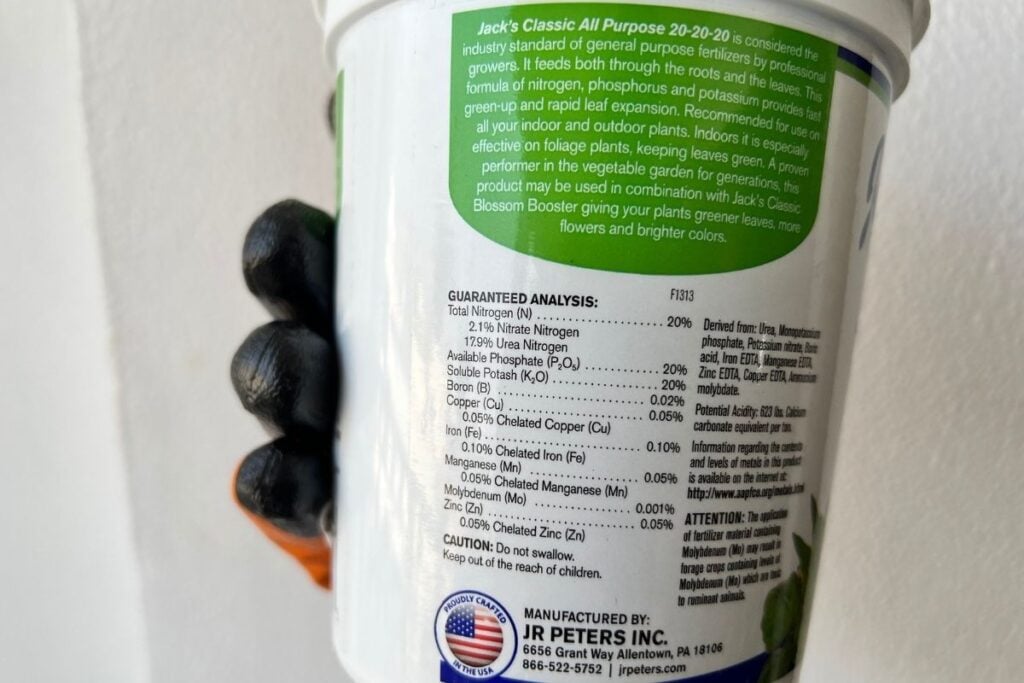
Sometimes, the plant might suffer from nutrient deficiency and grow slowly.
You can fertilize the plant during the months of spring.
It also helps them overcome the slow growth they faced during the previous winter and increase growth.
Don’t fertilize during the time of summer dormancy or winter.
You can use banana peels.
Cut the peels into pieces and mix them in the soil.
Banana peels have high potassium and release into the soil slowly.
Repotting and separating offsets
Don’t forget to repot the Aloe Veras once every 1-2 years.
Also, remove the pups in the process and transplant them.
It saves them from extreme root-bound and overcrowding and resumes their normal growth.
Also read: Does Aloe Vera Need Fertilizer? (How Much, How Often+Best Pick)
Container size
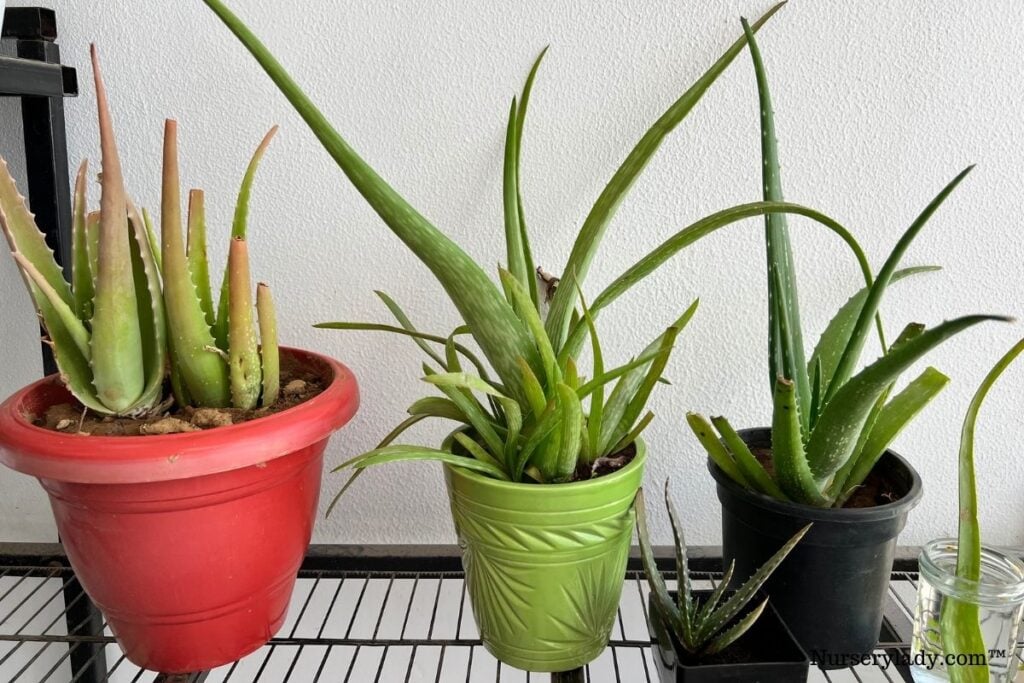
Always use a container depending on the size of the plant.
It should be only 1/3rd bigger than the plant.
Use 1-2 inches bigger than the present pot while repotting.
Always choose a wider pot and not a deeper pot.
A deep planter does the same job as a large one.
Ensure the drainage system of the container.
Drill one if drainage holes are absent. Use unglazed pots to reduce the moisture level in the plant.
It won’t let the plant grow slowly.
Also read: What Pot Is Best For Aloe Vera Plant? (Pot Type, Size & More)
Temperature
Aloes enjoy warm temperatures ranging between 55-75°F.
Protect the outdoor plants during the winters.
If your region receives frost, grow Aloes in containers.
When the temperature starts cooling in the fall, bring them inside.
Don’t let them stay outside if the temperature drops below 50°F.
It will give them both frost and freeze damage, the latter being the most dangerous one.
If your Aloe Vera is indoors, keep them away from open doors and windows.
Keep Aloe veras in a warm room.
Don’t keep your aloes too close to AC or fans.
Also, avoid the doors or windows that are frequently opened and closed to prevent temperature fluctuations.
Check for pests
Always observe the plant daily and closely, especially the underside of the leaves.
Avoid extremely damp or dry conditions in the plant.
If you ever see pest infestation, take immediate steps by spraying Neem oil.
This product is safe and won’t harm your plant.
Spraying some oil on the infected area in the beginning will stop them from spreading and keep your plant bug-free.
We don’t care much about all these things every time.
We overlook some points because we think they are silly and take Aloes for granted for their endurance level.
But focusing on these conditions can greatly change your plant’s health.
So, don’t forget to give attention to these situations.
It can prevent your plant from stopping its growth.
Final thoughts
Aloe Vera plant not growing doesn’t always signify the death or damage of the plant. Even if some reasons are real issues, it is fixable.
Aloe Vera stops growing when the temperature rises above 80-90°F as a strategy to preserve the water and use it during droughts.
They will resume growth when the temperature normalizes in the fall. It is common in outdoor Aloes. Aloes will also grow slowly in winters due to fewer sun hours and intensity.
Aloes will grow very slowly in low lights. Sunlight is an essential requirement for Aloe Vera. Use artificial lights for indoor Aloes if they don’t get enough light inside.
Avoid high moisture levels. Water the Aloe Veras when the 2-3 inches of the topsoil dries, use fast-draining soil that doesn’t hold moisture for long, take a terra cotta container with drainage holes and maintain low humidity. Avoid watering during dormancy and in winter.
Don’t use large containers. The container size should depend on the size of the plant and root ball. Protect the plant during cold temperatures.
Reference: NCBI, New York Botanical Garden, University of New Hampshire, University of Florida, Wikipedia.
